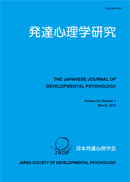
- Issue 4 Pages 167-
- Issue 3 Pages 113-
- Issue 2 Pages 53-
- Issue 1 Pages 1-
- |<
- <
- 1
- >
- >|
-
Mizuho Ueda, Emiko Katsurada2021Volume 32Issue 1 Pages 1-10
Published: 2021
Released on J-STAGE: March 20, 2023
JOURNAL FREE ACCESSThis research examines the developmental differences between positive and negative empathy in toddlerhood and how situational variables affect a child's empathetic responses. One hundred and twenty toddlers (1–3 years old) were observed as they performed two positive and two negative empathy tasks. Each task involved either their mothers or an examiner displaying a positive or negative affect as a result of a positive or negative event. The two tasks had clearly different causes for the affect. The children's empathetic responses were evaluated in each task, and results showed that toddlers' self-distress decreased with age in the negative empathy task, while their positive affect increased with age in the positive empathy task but only when the cause of their mothers' or the experimenter's affect was clear. Meanwhile, hypothesis testing hardly increases with age, and praising behaviors were rarely observed in positive empathy tasks. Next, this study's implications and future research directions are discussed.
View full abstractDownload PDF (744K) -
Saori Koyama, Masako Moriyama, Sachiko Kobayashi, Tomoko Obara2021Volume 32Issue 1 Pages 11-23
Published: 2021
Released on J-STAGE: March 20, 2023
JOURNAL FREE ACCESSThe study aimed to examine fathers' cognitive process in response to crying infants and investigate how the process changes as two-month-old babies progress in age to be four-months-old. Joint interviews were conducted with 10 pairs of parents when their infants were aged two and then four months. The analysis targeted 60 episodes. The fathers' cognitive processes in response to crying infants were classified into the following patterns: (i) cognitive process of elimination, (ii) iterative cognitive process, (iii) initial interpretation in the cognitive process, (iv) routine cognitive process, (v) trial-and-error cognitive process, and (vi) no cognitive processing. Similar to the case with the mothers, fathers interpreted the cause of infants crying based on “perception” and “situation.” Therefore, the study found that fathers exhibited characteristic patterns in cognitive processing toward infants aged two and then four months. The results suggested that fathers' cognitive processes change (i.e., from (i) cognitive process of elimination to (iii) initial interpretation in the cognitive process and (v) trial-and-error cognitive process) in response to cries of infants aged two and four months.
View full abstractDownload PDF (912K) -
Michika Takiyoshi, Mari Tanaka2021Volume 32Issue 1 Pages 24-36
Published: 2021
Released on J-STAGE: March 20, 2023
JOURNAL FREE ACCESSThis paper examines correlations between understanding autism spectrum disorder (ASD) and self-positiveness in typically developing (TD) individuals. Study 1 applied the literacy scale of ASD characteristics and self-positiveness scale to TD individuals (N=189). We deduced that TD individuals with a high awareness of ASD-related communication difficulties evaluated themselves as more sensitive regarding their relationship with others. We have discussed whether TD individuals positively or negatively assessed themselves as having proactive or closed attitudes about relationships with others by considering their personality factors. Study 2 examined changes in correlations between understanding ASD and self-positiveness in TD high school students (N=9), who participated in psycho-dramatic role-playing group work together with ASD individuals for approximately one year. Consequently, changes were indicted in the TD participants' self-affirmation subdomains that correlated with ASD-understanding subdomains. Concretely, TD participants came to understand ASD-related communication difficulties from environmental and individual perspectives. The background of these changes is discussed by considering participants' behaviors and remarks during group work.
View full abstractDownload PDF (807K) -
Minako Kimura, Yoshinobu Kato2021Volume 32Issue 1 Pages 37-48
Published: 2021
Released on J-STAGE: March 20, 2023
JOURNAL FREE ACCESSThis study investigated whether four- and five-year-old children believe that a photograph has the sensory properties of objects depicted on it (property realism). In Experiment 1, fifteen four-year-old and fifteen five-year-old children were presented with four kinds of real objects (strawberry cake, cactus, rose, and bell) and corresponding colored photographs. Each object was related to four sensory properties, such as taste, touch, smell, and hearing. The participants determined if the sensory properties of the real objects could be attributed to their iconic representations in the photographs. Experiment 2 used the colored and monochrome prints of the same objects with thirty-seven four-year-old and thirty five-year-old children to measure the effect of color on their judgments about property realism. The results revealed that the four-year-old children responded based on property realism, whereas most of the five-year-olds correctly responded that photographs had no sensory properties. Additionally, it was found that colored prints increased property realism than monochrome ones in both age groups.
View full abstractDownload PDF (854K)
- |<
- <
- 1
- >
- >|